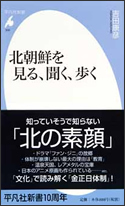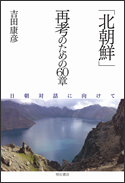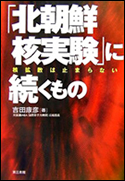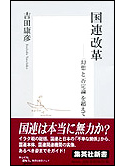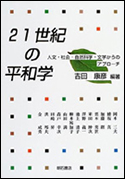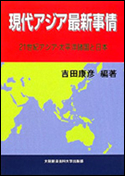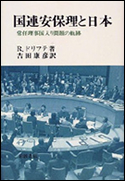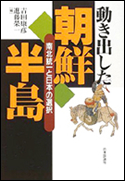2003年1月01日
【1】Misconceptions in the American Policy toward North Korea (January 2005)
INTRODUCTION/HISTORICAL BACKGROUND
A veteran American journalist and Korea-watcher, Don Oberdorfer, describes the Korean Peninsula as the land of surprise.(1) Most Americans and Westerners tend to describe it as such from curiosity. For the Koreans, however, it has been the land of tragedies with their country colonized and then their families and comrades killed and left split by the outside powers for a total of one century.
Korea is a peninsula of 222,347 square kilometers with a total population of slightly more than 70,000,000,(2) who had maintained an integrated nation under a single government with a distinctive language and strong traditions for the past 1,300 years. Belonging both to the Chinese civilization, Japan and Korea have introduced the dietary habits, letters and Confucianism from China. Unlike the Japanese, however, the Koreans created their own unique letters independent of the Chinese characters(3) and invented a metal-type printing system more than 200 years before Johannes Gutenberg’s invention in Germany.(4) Ceramic and porcelain art is at the world’s highest level.(5)
Since the dawn of the 20th century, the peninsula has experienced outside political interventions; 35-year-long direct colonial rule by Japan and 50-year-old East-West ideological confrontation resulting in the partition into two rival states. Japan’s colonization of the whole of Korea was acquiesced by the United Sates, which in a deal colonized the Philippines almost simultaneously at the beginning of the 20th century.
The fundamental misconceptions inherent in the U.S. policy toward Korea seems rooted from that period. For the Americans, Korea was merely a tiny backward country?target for colonization by any outside powers. Bruce Cumings quotes American officials in the 1910s, as saying that unlike the Filipinos, the Koreans were not ready yet for autonomy and democracy.(6)
After Japan’s defeat in the Pacific War in August 1945, the peninsula was divided into two military occupation zones and then two rival states, which were both thrown into stages of war with millions of Koreans killing each other for the sake of national reunification by force. This is the Korean War which lasted for three years from 1950 to 53 and ended in a draw without winners or losers.
The United States immediately intervened to counter what it regarded as the invasion by the communist forces from the North to protect its anti-communist “puppet” regime in Seoul in fear of possible Soviet domination of East Asia. In 1948, the Truman Administration adopted a new doctrine to contain communism from expansion.(7) The Korean people were thus victims of American military intervention.
In comparison with the Vietnam War, this should be questioned in retrospect. It is quite ironical that the U.S. withdrawal from South Vietnam in 1975 resulted in a national reunification of the whole country by a socialist regime, which now successfully promotes economic reforms with the infusion of American-style market mechanism under the Doi-moi policy. Washington normalized relations with Hanoi in 1995. Ho Chi Minh City, formerly Saigon, is busy and active with American businessmen.
It might be possible to legitimize the U.S. containment policy only in the context of the Cold War structure. Except for a cluster of the non-aligned nations mainly in Africa and Asia, later called the Third World, the international community was divided into two major rival blocs; the American-led free world and the Soviet-controlled communist world. For the Truman Administration, the Korean War was the first case of implementation of its containment policy, followed by the Berlin and Cuban Crises and the Vietnam War
The collapse of the Berlin Wall in 1989 ushered in a new post-Cold War period characterized by the disorganization of the Soviet Empire and its Socialist allies belonging to the Warsaw Pact and the COMECON bloc. The nations of Eastern Europe one after another introduced Western democracy and free-market economy systems, almost without bloodshed, except for Romania. (8)
In East Asia, however, the Cold War structure remains valid. The four-kilometer-wide demilitarized zone along the thirty-eighth parallel dividing the two Koreas still constitutes a forefront of ideological confrontation. Washington is responsible for the residual circumstances. The 37,000 American soldiers are stationed in the South as a counterbalance, while the Pentagon, as part of its transformation policy, plans to withdraw one-third of the total by the beginning of 2006.
Obviously, Washington has not got rid of its Cold War paradigm with regard to the Korean Peninsula, which prolongs solution of the whole issue and instead preserves tension over Northeast Asia. “The threat of North Korea,” in turn, serves to legitimize the U.S. military presence in the region. It should be questioned whether it is really in the interest of the nations and peoples concerned.
BIRTH OF THE DEMOCRATIC PEOPLES REPUBLIC OF KOREA (DPRK)
It might be useful to recall the historical evolutions during the post-war period. It was on September 2, 1948 that an ambitious young Korean partisan leader, Kim Il-sung, proclaimed independence of the DPRK in the north. (9) There was no other choice for Kim who had aspired for a free, independent and of course unified Korean state, once promised by the Allied Powers in their Cairo Declaration in November 1943, confirmed by the Yalta Conference in February 1945, and reconfirmed in the Potsdam Declaration in July 1945, which led to Japan’s unconditional surrender. In Yalta,U.S.President Franklin Roosevelt proposed a five-year international trusteeship over Korea to prepare for a free election for independence.
All this turned out an empty pledge with the outbreak of the East-West confrontation. In fact, the end of the Second World War in 1945 was simultaneously the start of the Cold War which lasted for nearly a half century. In the Korean Peninsula, the Americans propped up a staunch anti-communist politician, I Sung-man (Syngman Lee) in the Seoul presidency. A general election was held unilaterally in the south, amid a fierce revolt by local Koreans mainly in the Cheju Island in the southern-most small island off the Peninsula.(10) Under heavy American military guard, I Sung-man declared independence of the Republic of Korea (ROK) on August 15, 1948, the third anniversary of Japan’s defeat in the Second World War. Undoubtedly, it came as a great shock for Kim Il-sung, who in Pyongyang had been working hard to draft a constitution for a unified Korea.
Bruce Cumings concludes that the United States brought to power the three wrong persons in East Asia; Chang Kai Shek in China, I Sung-man in Korea and Ngo Dien Diem in Vietnam, only because they were staunch anti-communists. The lack of their popularity at home was totally ignored. (11)
This is the origin of the birth of two rival Korean states. According to Don Oberdorfer, the idea of the division came in Washington on 10 August 1945, on the eve of Japan’s defeat, when U.S. President Harry Truman proposed to Soviet leader Joseph Stalin a divided occupation of the hitherto Japanese-held territory. No American expert on Korea was involved in the proposal. Oberdorfer quotes Gregory Henderson, a former U.S. Foreign Service officer and noted Korea scholar as writing in 1974 that “No decision of a nation in the present world is so astonishing in its origin as the division of Korea; none is so unrelated to conditions or sentiment within the nation itself at the time the division was effected; none is to this day so unexplained; in none does blunder and planning oversight appear to have played so large a role. Finally, there is no division for which the US government bears so heavy a share of the responsibility as it bears for the division of Korea.”(12)
Since the division, reunification by force; namely expulsion of the U.S. imperialist forces from the south, had been a preoccupation for Kim Il-sung, who finally obtained approval of his Big Brother Stalin for his reunification scheme and assurance of Soviet military aid in arms and ammunition for that purpose. China’s revolutionary leader, Mao Tse-tung, also came in for help with hundreds of thousand Chinese soldiers, at a later stage after the War broke out.(13)
Classified Soviet documents released in the early 1990s disclosed that it was Kim Il-sung who advanced his troops into the south, triggering off the Korean War. However, what should really be questioned is that the division of a country retaining one ethnic identity was planned and carried out by the Americans without prior consultations with any Koreans at any stage.
Facing a massive U.S. military intervention with UN Security Council resolutions labeling the North as aggressor and dispatching the American-led coalition forces under the UN flag, Kim Il-sung found his ambitions frustrated. The presence of the two mutually hostile states was thus perpetuated. The principle of self-determination of peoples, initially proposed by President Woodrow Wilson as universal doctrine at the time of the creation of the League of Nations, was thus ignored. This should be questioned, although basically the Russo-American hegemony quest over the Korean Peninsula was to blame.
The American-led forces which fought the Korean War were identical to the multinational forces deployed in the 1991 Gulf War and the 2003 Iraq War. There was nothing to do with the UN Forces as defined by the UN Charter. Spelled out in details by Chapter Seven of the Charter, the UN Forces have never been formed or dispatched in the history of the world organization. The Korean War erupted while the USSR boycotted the Security Council debate over the Chinese representation issue. Therefore, the US could easily railroad any resolutions through the Security Council without being hampered by Soviet veto.(14)
The collapse of the Cold War structure brought a political and economic isolation to the DPRK, which had been resorting to guerrilla warfare and terrorist attacks in an attempt to topple the Seoul regime and liberate the people in the south from what it regarded as the yoke of American imperialists. The Rangoon incident in 1983 and the explosion of a South Korean passenger airliner over the Andaman Sea in the Indian Ocean, in 1987, were alleged to be typical examples of the DPRK’s terrorism.(15)
It was in the wake of these incidents that the United States called on its allies in Asia and Western Europe to invoke economic sanctions against the DPRK. The U.S. still refuses to remove the DPRK from the list of terrorist-supporting countries. Washington is one of the few countries in the world, which has no diplomatic relations with Pyongyang for these reasons. The others are Japan and France. France, which attaches importance to the DPRK’s human rights violations, however, did not oppose the European Union (EU) opening diplomatic ties with Pyongyang.
Instead of normalizing relations, the Bush Administration, upon its inauguration, even intensified its containment and confrontation policy toward the DPRK, which it included in the Exis of Evil, together with Iran and Iraq.(16) It should be reviewed and questioned whether it has been productive and successful in the interest of peace and stability of Northeast Asia.
DISCLOSURE OF A CLANDESTINE NUCLEAR PROGRAM
Circumstantial evidence is that Kim Il-sung’s ambition for nuclear weapons was prompted by the abortive U.S. plan to drop nuclear bombs during the 1950-53 Korean War. General Douglas McArthur, the commander-in-chief, had submitted to the White House a list of targets for nuclear bombing, which was later believed to have influenced Kim to compromise on a cease-fire agreement. McArthur’s plan was turned down by President Truman in fear of the breakout of a Russo-American nuclear war.
In 1956, the DPRK signed an agreement with the Soviet Union on technical cooperation in nuclear research, starting sending an average 50 young students to the Dubna Research Center near Moscow every year. They were trained in basic nuclear science and engineering, which certainly served as a basis for the nation’s nuclear development program. Hwang Jang-yop, ex-aide to Kim Il-sung and architect of the Juche ideology, confessed in Pyongyang in 1996 before his defection to Seoul that the academic level of Korean students was appreciated so highly by the Russians that one of them was awarded the Lenin Prize for his studies of elementary particles.(17)
It is nothing but the flip of a coin whether a nuclear program remains limited to peaceful uses to generate electricity or is diverted for military purposes to manufacture weapons. Both enriched uranium and plutonium, a by-product of uranium nuclear fission, are materials for dual purposes. It is the safeguard system of the International Atomic Energy Agency (IAEA) which gives assurance to its Member States as regards their nuclear-related activities for peaceful purposes.
During the 1960s, the USSR provided a small experimental nuclear reactor at Yongbyon, some 160 kilometers north of Pyongyang. Placed under the IAEA safeguards, it started operations in 1965 as the nation’s first nuclear reactor. Yongbyon thus became a center of the DPRK’s nuclear activities, where the North Korean engineers later started construction of two graphite-moderated reactors using natural uranium as fuel. North Korea is rich in natural uranium ores.
Construction of these two reactors detected by satellite pictures, came as a surprise to American officials as a possible clandestine weapons program. The first of the two, a five-megawatts reactor, suspended operations obviously to replace spent fuels for reprocessing. Construction of another oblong-shaped building presumed to be a plutonium reprocessing plant in the same compound was also detected by satellite observations during the late 1980s.
Concerned about the DPRK embarking on its own nuclear weapons program, new Soviet leader Mikhail Gorbachev pressed Pyongyang leaders to sign and ratify the Nuclear Non-Proliferation Treaty (NPT), under which non-nuclear weapon states are obliged to place all nuclear materials under the IAEA safeguards by concluding an agreement with the IAEA within 18 months upon admission. The DPRK signed and ratified it in December 1985.
The IAEA held negotiations on-and-off in Vienna with DPRK diplomats and nuclear experts from 1986 to 1989 to sign a bilateral safeguard agreement. Refusing the IAEA’s request under the treaty obligation, the North Koreans claimed that the IAEA’s inspections should also be conducted on U.S. military bases in the South, where hundreds of Tomahawk tactical missiles mounted with nuclear warheads were presumed to be stockpiled.(18) A joint U.S-ROK military exercise was performed every year in the south to counter possible attacks across the military demarcation line from the north.
The IAEA simply responded that such a political issue should be discussed directly with the US government. The North Korean diplomats confessed that Washington gives no ear to their arguments. Conclusion of the IAEA-DPRK safeguard agreement was thus delayed until 1992, when Washington finally came closer to full negotiations with Pyongyang. It was thus obvious that the DPRK’s alleged nuclear program was a mere bargaining chip to deal with the United States.
It was in November 1989 that the first US-DPRK contact was made at the counselor’s level in Beijing. The American diplomats insisted that the DPRK abandon the whole nuclear program, placing all related facilities under the IAEA inspections, while the Koreans urged the Americans to conclude a peace treaty, thus normalizing bilateral relations. All this is more or less the same as the arguments still going on today, 15 years afterwards.
Both sides are rigid and adamant. Why? The reasons should be questioned.
Briefly, Pyongyang is extremely proud of its nationalism and independence, while Washington, superpower-minded, is inclined to act as a policeman for the whole world.
Basically, the DPRK, since the end of the Cold War, remains unchanged in its die-hard attempts for political survival, demanding conclusion of a peace treaty or at least a non-aggression pact with the United States, officially putting an end to the Korean War, which is still at the level of a temporary cease-fire. The Armistice Agreement was signed at Panmunjom on July 27, 1953, by the field commanders of the two main fighters, the American and North Korean Forces. From Pyongyang’s standpoint, therefore, the DPRK’s national security remains vulnerable, until peace and security on the Korean Peninsula is guaranteed in the form of legally-binding documents. It is only Washington who could guarantee it. (19)
Kim Jong-il and his close aides are strongly suspicious that the Bush Administration might be tempted to cash in on an opportunity to topple his regime, thus shelving normalization of diplomatic relations. President George Bush has, on several occasions,(20) termed Kim Jong-il as dictator, saying that he has a strong sense of distrust on Kim who, he said, makes millions of Koreans dying of hunger and starvation. He even called Kim a pygmy. During his election campaign speeches in August, 2004, Bush said, “Kim Jong-il is a tyrant.” Such a direct, impolite and indiscreet personal attack should really be questioned. His predecessor, Bill Clinton, had never done so.
George Bush’ remarks only jeopardized the whole atmosphere surrounding the US-DPRK relations. It must be remembered that the Koreans are highly prideful and honor-conscious people.
MYSTERY OVER THE DPRK’S URANIUM ENRICHMENT PROGRAM
It was on October 3-5, 2002 that James Kelly, U.S. Assistant Secretary of State visited Pyongyang and showed to DPRK officials a copy of export license which the US had sub rosa obtained from the Pakistani military. The copy indicated that the DPRK had imported a set of centrifuge machinery for uranium enrichment from Pakistan through Dr. Abdel Qadir Khan, the father of Pakistani nuclear bombs.(21) Kim Kye-gwan, DPRK Vice Foreign Minister, remained silent and at least did not deny, according to a State Department announcement. After a recess, Kang Sok-ju, First Vice Foreign Minister, was reported to have come to admit Kelly’s allegation.
On the basis of Pyongyang’s “affirmative” response, the U.S. decided to suspend heavy oil supplies to the DPRK under the arrangement of the Korean Energy Development Organization (KEDO), kicking off a new spell of North Korea’s nuclear crisis.(22) The KEDO suspended construction of one of the two light-water reactors at Kum Pho, north of Pyongyang. In retaliation, the DPRK withdrew from the Nuclear Non-Proliferation Treaty (NPT), expelled two IAEA inspectors and openly resumed plutonium reprocessing operations.
An objective assessment is indispensable. It is still unclear what was the exact reaction of the Pyongyang officials to James Kelly. The DPRK has repeatedly denied that they had admitted Kelly’s argument and that they have any uranium enrichment program at all. Pyongyang’s official Central Korean News Agency quotes Kang as having negatively responded to Kelly, saying that the DPRK is entitled to develop weapons even stronger than nuclear arms, that is the force of the people’s unity.(23)
The uranium issue is still pending, as Pyongyang keeps denying. It is highly unlikely that the DPRK has embarked on uranium enrichment work, even if some instruments were imported from Pakistan. A uranium enrichment plant requires a large space of facilities with high-power electricity supplies, which U.S. intelligence has not been successful in detecting anywhere in North Korea.
WHO BROKE THE AGREED FRAMEWORK
In retrospect, the Clinton Administration was initially suspicious of Pyongyang’s real intention in pursuing a nuclear development program. Since it is the fundamental policy of any U.S. administration to prevent proliferation of nuclear weapons, President Clinton was prepared to wage a second Korean war by alerting the American forces in South Korea, Japan and the Western Pacific region to counter the DPRK’s brinkmanship policy. Tension mounted in Northeast Asia in early June 1994, when Washington brought the case to the UN Security Council to draft a resolution to invoke economic sanctions against the DPRK, which had announced any UN sanctions would mean a declaration of war against Pyongyang.
It was Jimmy Carter, former U.S. President, who crossed the DMZ from the South to the North on June 15, 1994, and held face-to-face talks with the DPRK’s Head of State Kim Il-sung to avert a confrontation. Carter did it. Since he retired, Carter has been vigorously pursuing preventive diplomacy in his personal capacity. His title of a former president of the world’s super-power as peace emissary was more than enough to satisfy the prestige-conscious Pyongyang leadership.
Briefly, Carter and Kim Il-sung agreed on a deal to freeze the DPRK’s nuclear facilities in question in Yongbyong, including two graphite-moderated reactors, in return for two proliferation-resistant light-water reactors to be supplied by the U.S. side (actually by South Korea and Japan in large part.) The compromise formula had been worked out by a group of American experts including Serig Harrison,(24), who had held prior contact with North Korean leaders in Pyongyang in April and May, while tension was mounting around the Korean Peninsula. Both sides found it necessary to give a ceremony to be transmitted all over the world on CNN TV network.
In less than a month, “the Great Leader” Kim, suddenly died of a heart attack on 8 July 1994, while preparing for a North-South summit with Seoul’s President, Kim Yong-sum, scheduled for later in July. This was also part of the Kim Il Sung-Carter agreement. Though the North-South summit became abortive, President Clinton welcomed Carter’s achievements. He instructed Robert Gallucci, Assistant Secretary of State, to hammer out a detailed agreement with the DPRK. Negotiations started in Geneva in July and, after a brief recess due to Kim Il-sung’s death, ended successfully with the conclusion of an Agreed Framework on 21 October 1994. His DPRK counterpart was Kang Sok-ju, Vice Foreign Minister, later promoted as First Vice Foreign Minister.
Kenneth Quinones, on hand to attend the Geneva talks,(25) recalls Kang as a tough and competent negotiator and admits that Gallucci and Kang could reach a degree of mutual understanding and respect after three months of intensive talks in Geneva. The Korean crisis would have been overcome, provided the Agreed Framework was implemented at least by the US side faithfully. This should be questioned.
Upon his return to Pyongyang, Kang received a triumphant welcome from hundreds of Party and Government officials in appreciation of his successful negotiations with the Americans in Geneva.(26) He witnessed that a red carpet was unrolled on the airport field to welcome Kang? evidence to hail the DPRK’s diplomatic victory.
In addition to the freeze of North Korea’s nuclear facilities and the supply of two light-water reactors, the Agreed Framework, in its second article, stipulates that both sides will lower barriers in trade and investment, including restrictive measures in communication services and financial transactions within three months・・・・and to open a liaison office respectively in each other’s capital in the understanding that it will be upgraded to an ambassadorial level. This was exactly what Pyongyang had been seeking as its diplomatic goal. At least for the DPRK, it was a first step toward normalization of diplomatic relations with Washington.
Therefore, it should be noted that there was no reason for the DPRK to break, from their side, the Agreed Framework, which is so advantageous in its provisions that Kang was accorded a hero’s welcome at the airport, and that soon afterward he was promoted to First Vice Foreign Minister with the privilege of direct access to “the Dear Leader”, Kim Jong-il.
To the deception of Pyongyang, however, the Clinton Administration neglected to implement the Agreed Framework, once the NPT was given an indefinite and unconditional extension at the Treaty Review Conference in New York in April-May 1995. Since the crisis was gone, Gallucci was optimistic about the future of the DPRK’s nuclear program, which he believed would be phased out under the KEDO scheme. All in all, he admitted, Washington had anticipated that the Kim Jong-il regime would collapse not in the distant future.(27) Nicolas Everstadt was one of the American intellectuals who had made such a prediction, saying that the DPRK was on the verge of collapse.(28) ROK President Kim Yong-sam was also responsible for having influenced Washington with a similar prediction. Kim Yong-sam, anxious to be the first President of a unified Korea, was, however, hated by Pyongyang for his anti-DPRK remarks and behavior.(29)
The second article of the Agreed Framework was thus not followed up by Washington almost at all, while the Clinton Administration came to realize the need to implement it only in the last months and days of its term. It was an irrevocable miscalculation on the U.S. side. This should above all be questioned.
Disgruntled, the DPRK fired a Taepodong missile over the Japanese Archipelago in the Western Pacific on 31 August 1998,(30) and fabricated another clandestine nuclear site in Kum Changli in the north, which was later identified by a visiting American expert team as merely a huge cave. These were regarded as a series of gestures by Pyongyang in protest against the American negligence to fulfill the Agreed Framework as provided.
The newly-alleged uranium enrichment program should thus be interpreted within this context. It would not be surprising if the DPRK leaders might have been tempted to develop uranium-made bombs in technical cooperation with Pakistan, which is believed to have been a good customer of medium-range North Korea-made missiles, code-named Nodong. In addition, the Agreed Framework itself does not prohibit the DPRK from embarking on uranium enrichment. The only reference in the Geneva accord is to the DPRK’s respect for the 1991 North-South Denuclearization Declaration, which bans uranium enrichment and plutonium reprocessing on both North and South. However, the prohibition is indirect and the declaration itself was regarded as a dead document.
What really dealt a heavy blow to Kim Jong-il was the last-minute victory of George Bush Jr., in the 2000 Presidential Election. Upon assuming presidency in January 2001, Bush reversed the final moves of the Clinton Administration toward normalization of diplomatic relations with Pyongyang. Former Defense Secretary William Perry, nominated by Clinton as special envoy, had submitted a comprehensive report in September 1999, proposing a direct deal with the Kim Jong-il regime as it is. A military confrontation, the report had said, would involve millions of victims, both American and Korean. Following the so-called Perry Process, Secretary of State Madelene Albright visited Pyongyang in October 2000 to wind up a final stage of negotiations and prepare for Clinton’s own visit.
The year 2000 should also be remembered with the historic North-South summit held in Pyongyang in June. President Kim Dae-jung flew from Seoul, implementing his own Sunshine Policy toward the DPRK. President Kim was thus awarded the Nobel Peace Prize in December 2000.(31)
However, as reiterated in other parts, Kim Jong-il’s real target as counterpart is not Seoul, but Washington. Under the existing security framework, all the South Korean forces are placed under the U.S. Command, should a crisis once happen. Peace and security all over the Korean Peninsula is in the hands of the Americans.
Bush’s victory was a nightmare for Kim Jong-il. Washington’s move toward detente and thaw was halted and reversed by Bush’s ABC policy.(32) Pyongyang learned a bitter lesson. Nothing can be trusted unless a legally-binding bilateral treaty is concluded with Washington. This should be remembered. The DPRK again became a victim of the Big Power egotism.
Furthermore, President Bush, in his State of Union message in January 2002, branded the DPRK as well as Iran and Iraq, as the Axis of Evil, fixing them as target of “pre-emptive attacks.” In July 2002, President Bush suddenly demanded unilateral dismantlement of all nuclear weapons as well as conventional arms, as pre-requisite to any deal with Pyongyang. Is it unrealistic if Kim Jong-il and his leadership interpreted all this as hostile to them and regarded the Agreed Framework as no longer valid? George Bush had refused to negotiate with the DPRK, even before James Kelly visited Pyongyang in October 2002 with uranium enrichment suspicions.
All the media in Japan was a mere rubber stamp of the U.S. claim in accusing the DPRK of violating the Agreed Framework with the clandestine uranium enrichment program. This should be reviewed and questioned.
ROAD TO A SOLUTION/FUTURE OF THE SIX-PARTY TALKS
A solution to the Korean crisis over the DPRK’s nuclear issue is simple. It is to recognize the Kim Jong-il regime as such, open diplomatic relations, conclude a peace treaty officially ending the Korean War, and lift economic sanctions by removing it from the list of terrorist-supporting nations. All should and could be done only by the United Sates. Washington has often been puzzled and confused with the real intention of Pyongyang, because it has been using its nuclear program not only as a bargaining chip, but also as a tool for blackmail and threats.
The Bush Administration, emerging as the world’s sole super-power, dared not yield to any blackmail or threat, especially after the 9.11 terrorist attacks in 2001. The whole game was put back again to the start. This should be questioned. Bush’s attitude is a Super-Power arrogance.
However, the third round of the six-party talks in Beijing in June 2004 marked a turning point.(33) For the first time since its inauguration, the Bush Administration showed flexibility by presenting a compromise proposal. Withdrawing from its hitherto demand for comprehensive, verifiable and irreversible dismantlement (CVID), James Kelly announced that the US would be ready to approve its allies’ energy and other economic assistance, and provide temporary security assurance to the DPRK in reciprocity if Pyongyang agrees to freeze its nuclear-related program with verification, as a first step toward total abolition of all nuclear programs. It will take time, however, before progress is made since there is deep distrust between the two sides.
The policy change in the Bush Administration was taken as a result of persuasion by Seoul and Tokyo. It was also interpreted as a countermeasure to John Kerry, Democratic Party Presidential candidate, who had insisted upon a direct deal with Kim Jong-il for an immediate solution of the crisis.
Here is one episode. The third round of the Beijing talks came just weeks after Prime Minister Koizumi’s second visit to Pyongyang on 22 May 2004. During their talks, Kim Jong-il confessed to him; “I would like to sing a song in a duet with President Bush until the limit of my voice.” George Bush showed no reactions.(34)
A solution, therefore, would have been easier with Kerry’s victory. During his campaign speeches, Kerry said he would follow what his Democratic predecessor Bill Clinton had tried to achieve. Pyongyang was expecting Kerry winning the race. However, Bush’s re-election warrants some optimism.
With the deteriorating situation in Iraq on the one hand, George Bush would find no other choice than seeking a diplomatic solution to the Korean crisis and accommodating a multilateral forum, such as the six-nation talks in Beijing.
Three out of the four other participating nations, China, Russia and South Korea, have reached a broad consensus on reciprocal compromise on the pending issues, which they consider could be settled on a step-by-step basis with the IAEA and some other international verification system to achieve the DPRK’s final abolition of nuclear weapons program.
Only Japan changed its attitude more hawkish than before in November 2004, freezing all humanitarian assistance and possibly invoking economic sanctions over the abduction case, in which Japan claims the DPRK had showed an insincere attitude in response to Japan’s demand for releasing all Japanese abductees whom the DPRK announced dead but their families believe alive. The abduction issue, however, is unlikely to be settled to Japan’s satisfaction.
Here again, Pyongyang is expected to concentrate again on Washington for a direct deal on its political survival. There are reasons to believe that President Bush, in his personal concern, might be interested in making a visible diplomatic achievement ―to be recorded in history―during his second term. Bill Clinton, his predecessor, was in a similar position during his second term. Korea and Palestine were ahead of him for his choice. He failed in either of the two.(35)
SUCCESSION ISSUE AND ECONOMIC REFORM――FUTURE
Much is rumored about who would be successor to Kim Jong Il, who is now
63 years old. At this age of his father in 1974, he had already been picked up as the de facto successor to Kim Il-sung, though officially nominated in 1980.
Kim Jong-il has at least three sons by two successive wives. However, nobody has so far been designated as an heir to the throne, apparently because the Pyongyang leaders are aware that hereditary system for a socialist state is a contraction, and because Kim Jong-il himself still wants to be an active leader. Born on 16 February 1942, Kim reportedly told his close aides that he would remain active until the age when his father died. His father died at 82.
North Korea-watchers in Tokyo and Seoul, however, predict that, in fact, there is rivalry behind the scenes between Kim Jong-nam, the eldest son by the now-dead second wife, and Kim Jong-chol, the eldest by the Japan-born fourth wife, as a prospective successor. A Japanese-born Korean journalist, Ha Shin-gi, discloses that the latter has already been picked up as successor. (36)
In any case, the most probable choice for the DPRK’s future political system would be a collective leadership with competent technocrats in each post given the chance to take their own initiatives and make decisions. This could be a step toward gradual democratization.
I have visited the DPRK six times since 1994. Whenever I go to Pyongyang, I have been impressed with junior Government and Party officials fluent in several languages and informed of up-to-date developments in the outside world. University graduate elites, mostly sons and daughters of the high-ranking Party officials, are allowed to watch satellite TV news for 24 hours and access to Internet communications. They are not disposed to accept dictatorship with one-family rule for a long period.
The DPRK’s 60-year-old dictatorial power structure may eventually bring about either of Kim Jong-il’s sons being picked up as his successor, who, however, is highly likely to remain a figure head as symbol under a collective leadership system. It should be noted that succession of power within a family happens in other nations in Asia, such as India, Indonesia, Pakistan and Singapore.
The introduction of free-market economy system, as in China, has been in progress, as one of the most important tasks facing the Kim Jong-il regime. The DPRK Government introduced economic reform measures in July 2002, in anticipation of billions of US dollars in aid from Japan, which the DPRK had expected in the wake of Prime Minister Koizumi’s visit to Pyongyang in September. In fact, signing the Joint Pyongyang Declaration, Koizumi apologized for Japan’s colonial rule in the past and agreed to extend economic cooperation, which, however, has not been implemented due to the prolongation and aggravation of the abduction issue.
In the absence of foreign capital investment and consumer goods, therefore, commodity prices have recorded hyper-inflations with free-market stalls mushrooming in local towns and villages. Approximately, there are reportedly 40 free-market shops and stored dealing with liberalized goods in Pyongyang alone, with total number of 300 all over the country. (37)
On the other hand, food and energy shortages are still chronic and perennial. The nation is short of an average one-million tons of grains every year. Normalization of relations with Japan and the United Sates is, therefore, needed not only for allowing political survival of the Kim Jong-il regime for the peace and stability of the Korean Peninsula, but also for ensuring, for humanitarian reasons, physical survival of the 22-million people living in the North.
It is exactly 10 years ago that the Institute of International Strategic Studies in London expressed a surprise and amazement at docility and obedience of the Korean people suffering from chronic food and energy shortages. Elsewhere in the world, it pointed out, any government would not be able to survive; it would be collapse under popular revolts and mutinies. Bruce Cumings, at the end of his most recent publication, North Korea: another country, quotes a CNN executive, Eason Jordan, as telling Harvard University students, that the North Koreans would keep surviving and that the Pyongyang regime could not be toppled by the United States or any other countries in the world. (38)
In this sense, Don Oberdorfer was right in describing the Korean Peninsula as the land of surprise. (2004?12-31)
【Footnotes】
(1) Don Oberdorfer: The Two Koreas, a contemporary history, Basic Books, U.S. and Canada, 1997
(2) United Nations statistics, 2003.
(3) The letters, called Han Gul, were invented by a group of Korean scholars in 1443.during the Lee Dynasty. North Korea has totally abolished Chinese characters on Kim Il-sung’s order.
(4) A metal-type printing system was invented by the Koreans before 1234, at least 220 years before Gutenberg did. Source:“Policy Forum”No.15, March 2004, and other reports by Dr. Jeong Man U, Professor Emeritus, Osaka University of Economics and Law.
(5) Originated from China, the Koreans developed a unique pottery and porcelain art. In the 11th century, the celadon porcelain ware made in Korea was most admired in China and Japan. It was Korean potters settled in Japan who propagated porcelain art in Japan.
(6) Bruce Cumings: The Origin of the Korean War, Princeton University Press, 1981
(7) Called “Truman Doctrine”, the policy was adopted from George Frost Kennan’s theory to contain communism.
(8) In Romania, President Nikolae Ceausescu and his wife were executed after a popular summary trial in December 1989. Shocked with the report, Kim Il-sung and his son, Kim Jong-il, were reportedly determined to take all precautionary measures for their survival.
(9) Kim Il-sung, born in Pyongyang on 15 April, 1912, joined the Chinese Communist Party, taking part in the anti-Japanese partisan guerrilla squad, and made a triumphant return to Pyongyang from Vladivostok aboard a Soviet vessel in October, 1945. Expelling all his rivals, Kim was preparing for ruling the whole of Korea as an independent nation, when the Americans created the anti-communist Republic of Korea with Seoul as capital and with I Sung Man as President.
(10) In the so-called 4.3 mutiny, the Cheju Islanders revolted against the U.S. occupation forces and the Seoul authorities holding unilateral elections for independence of the South, thus invalidating the elections on the island. The mutiny lasted for seven years, during which time an estimated 80,000 islanders were killed.
(11) Bruce Cumings: North Korea, Another Country, The New Press, New York, 2003
(12) Don Oberdorfer, ibid.
(13) The Korean War claimed the lives of 1,260,000 people of both North and South and those of 33,629 American soldiers with 8,177 missing, according to a UN Command announcement in 1991. Actual figures are estimated much greater. The Chinese Army took part in November 1950 and incurred the loss of 847,000 dead and missing, according to the UN announcement. The cease-fire agreement was signed by the DPRK, the U.S. and China, but not by South Korea. President Syngman Lee opposed it. It is the legal ground why the DPRK has not accepted South Korea as official counterpart for a long time.
(14) In the absence of the USSR from the Security Council, the U.S. branded the DPRK as aggressor and held responsible for destroying international peace and security. The U.S. mobilized 16 allied nations in the Korean War, but no legal procedures were followed for the deployment of the UN forces, as provided by the UN Charter.
(15) The DPRK has not officially recognized the two incidents as its terrorist acts. Pyongyang, however, has acknowledged the assassination of the wife of former ROK President Park Chung-hee in 1974 and the abduction of Japanese nationals as the deed of “agents of special assignments.”
(16) The Axis is taken from the Axis states (Japan, Germany and Italy) during the 2nd World War, and Evil from the Empire of Evil, meaning the USSR during the Reagan Administration. Iran, Iraq and North Korea have been classified as terrorist-supporting nations possessing weapons of mass destruction. Nothing was discovered in Iraq, however. And in fact, the three nations does not constitute any alliance or connections as called the Axis.
(17) Hwang Jang-yop personally told me during my visit to Pyongyang in August 1994.
(18) During my duty as Director of Public Information, IAEA, I observed the IAEA-DPRK negotiations in Vienna, during which the Korean officials made such statements. The Korean Central News Agency also made such reports during that period.
(19) Only few people, even in Washington, understand the basic nature of North Korea’s nuclear issue. See Bruce Cumings:North Korea, Another Country (Chapter Two?Nuclear Crisis, First Act and Sequel)
(20) George Bush referred to Kim Jong-il in his talks with President Roh Moo-hyon of ROK, Prime Minister Koizumi of Japan in Washington in 2001 and 2002. Bruce Cumings is also critical of Bush. (ibid.)
(21) Dr. Khan admitted that he had exported nuclear technology and materials to Iran, Libya and North Korea “from his own personal desire to accumulate his fortune.” (New York Times, 21 February 2004) Dr. Khan confessed to the Pakistani authorities that he was shown five nuclear devices in North Korea during his visit five years ago. (New York Times, 13 April 2004) North Korea’s reactions to James Kelly’s claim was disclosed in Washington to visiting former Japanese Prime Minister Ryutaro Hashimoto. Souce:The Asahi Shimbun and other Japanese newspaper reports on 17 October 2002.
(22) The KEDO, inaugurated in March 1995 on the basis of the Agreed Framework, is composed of the United States, Japan, South Korea and the EU. Construction of the first of the two planned light-water reactor was to be completed by 2003 under the KEDO scheme, but was largely delayed for technical reasons.
(23) Foreign Ministry statement reported by the Korean Central News Agency on 25 October 2002.
(24) Former Washington Post correspondent for the Far East and senior researcher of the Carnegie Foundation, holding an interview with Kim Il-sung and being trusted by the Pyongyang leadership as a drafter of a roadmap acceptable to both sides.
(25) Kenneth Quinones: North Korea’s Nuclear Threat “Off the Record” Memories, Chuokoron-shinsha,
Tokyo, 2000
(26) This was witnessed by Won Yong-chol, Japanese-born Korean journalist of the Chosen Jiho, who happened to be at Pyongyang airport in early November 1994 on his way home to Tokyo. Direct hearing from Won Yong-chol.
(27) Statement by Robert Gallucci in a symposium in Tokyo in 1996.
(28) Nicolas Everstadt: The End of North Korea, American Enterprise Institute, Washington, 1999
(29) Kim Yong Sam refused to send a cable of condolence and rejected to dispatch a condolence mission to Pyongyang on the occasion of Kim Il-sung’s death. I was in Pyongyang soon afterward in August, hearing direct personal attacks against the South Korean leader from senior Party and Government officials.
(30) The whole Japanese nation was thrown into panic on the report of the Taepodong shot, as if a direct attack. Both Houses of Japanese Parliament unanimously adopted anti-DPRK resolutions and the Government unilaterally invoked economic sanctions, which, however, were lifted a month later under U.S. pressure. For further details, YOSHIDA Yasuhiko: Dimmed prospects on an Early Normalization of Diplomatic Relations between Japan and the DPRK, Saitama University Bulletin, Vol.34 No.2, 1998
(31) Kim Dae-jung: The Three-state Approach to Korean Reunification, Focusing on South-North Confederal State, Kim Dae-jung’s Peace Foundation, Seoul, 1995
(32) ABC stands for Anti-Bill Clinton Policy. The Bush Administration, upon its inauguration, froze his predecessor’s policy toward the DPRK for review, reversed it and finally rejected any direct talks with Pyongyang.
(33) Under George Bush’s proposal, the first six-party talks were held in Beijing in August 2003, and second in February 2004.
(34) Japanese newspaper reports covering the Japan-U.S. summit in June 2004. Most recently, the Yomiuri
Shimbun’s feature on December 30, 2004.
(35) Bill Clinton: My Life, 2004
(36) Ha Shing-gi analyses that Kim Jong-nam has lost the chance of being successor, when he was detained by Japanese police at Narita Airport in May 2001, on suspicion of illegal entry into Japan.
(37) Bruce Cumings put the figure at 3,000 or more in his book “North Korea, another country.”
(38) With the enactment of the North Korean Human Rights Act in U.S. Congress in October 2004, the Bush Administration in its second term appears prepared to apply “regime transformation” policy, instead of “regime change”, on the DPRK. All remains to be seen.
【References】
Cumings, Bruce. The Origin of the Korean War, vol.2, Princeton, N.J., Princeton
University Press, 1981
Cumings, Bruce. North Korea: Another Country, The New Press, 2004
Eberstadt, Nicolas. The End of North Korea, American Enterprise Institute,
Washington, 1999
Gertz, Bill. Betrayal, How the Clinton Adminisration undermined American Security,
Regnery, New York, 1999
Harrison, Selig S. Korean Endgame: A Strategy for Reunification and U.S.
Disengagement. Princeton, N.J; Princeton University Press, 2002
Kim Hak-joon, Whether Path for the Two Koreas in the 21st Century, Jimoondang
Publishing Company, 1998, Seoul
Oberdorfer, Don. The Two Koreas: A Contemporary History, New York, Addison
Wesly, 1997
O’hanlon, Michael & Mochizuki, Mike. Crisis on the Korean Peninsula, McGraw-Hill,
New York, 2003
Quinones, Kenneth, C. North Korea’s Nuclear Threat: “Off the Record” Memoires,
Ridgway, Mathew Bunker. The Korean War, Doubleday & Company, Inc., New
York,1967
Snyder, Scott. Negotiating on the Edge, North Korean Negotiating Behavior, United
States Institute of Peace Press, Washington, 1999
Sunohara, Tsuyoshi, Hidden History of US-DPRK Negotiation, Nihon Keizai
Shimbun Press, Tokyo, 2004
【Japanese References】
李 韓永『金正日が愛した女たち』徳間書店、2001年
伊集院敦『金正日「改革」の虚実』日本経済新聞社、2002年
小此木政夫『朝鮮戦争――米国の介入過程』中央公論社、1986年
小此木政夫編『ポスト冷戦の朝鮮半島』日本国際問題研究所、1994年
小此木政夫ほか監修『資料・北朝鮮研究』慶應義塾大学出版会、1998年
小都 元『核武装する北朝鮮』新紀元社、2003年
鎌倉孝夫ほか編『入門・朝鮮民主主義人民共和国』雄山閣、1998年
川上和久『北朝鮮報道――情報操作を見抜く』光文社新書、2004年
金正日『人間の証し(原題=映画芸術論)』発行=同朋社・発売=角川書店、2000年
キム・ミョンチョル『金正日 朝鮮統一の日』光人社、1998年
キム・ミョンチョル『金正日 核の陰謀』光人社、2004年
金大中アジア太平洋平和財団『金大中平和統一論』朝日新聞社、2000年、
島田洋一『アメリカ・北朝鮮抗争史』文春新書、2003年
成 恵浪『北朝鮮はるかなり』上下、文芸春秋、2001年
全 哲男『銃声なき朝米戦争』社会評論社、1999年
全 哲男『脅威の国との国交交渉』緑風出版、2000年
河 信基『金正日の後継者は「在日」の息子』講談社α新書、2004年
朴 振『これが北朝鮮核問題のすべてだ!』東洋経済新報社、2003年
黄 長?『金正日への宣戦布告/黄長?回顧録』文芸春秋、1999年
黄 長?『狂犬におびえるな/続・金正日への宣戦布告』文芸春秋、2000年
フォーリン・アフェアーズ・ジャパン編『アメリカと北朝鮮』朝日新聞社、2003年
三好正洋『わかりやすい朝鮮戦争』光人社、1999年
森 千春『朝鮮半島は統一できるのか』中公新書ラクレ、2003年
吉田康彦・進藤榮一編『動き出した朝鮮半島』日本評論社、2000年
吉田康彦『現代アジア最新事情』大阪経済法科大学出版部、2004年(改訂3版)
和田春樹『朝鮮戦争』岩波書店、1995年
和田春樹『北朝鮮――遊撃国家の現在』岩波書店、1998年


